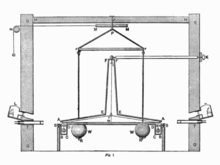Gravitational balance
The gravitational balance is the measuring instrument in a physical experiment (also called the Cavendish experiment ) to determine the gravitational constant , which determines the strength of the gravitational attraction between masses. So it gives a measure of the strength of gravity .
In 1798 Henry Cavendish used such an apparatus to determine the density of the earth for the first time . Although Cavendish himself was not interested in the gravitational constant, his experiment succeeded in calculating its value almost exactly.
construction

Essentially, it is a rotary balance , as it is also used in applied geophysics . "Torsional balance" means that the amount of the angle by which a wire is twisted from its rest form provides information about the effective torque . The force acting between the test masses can be calculated from this.
Specifically: A wire hangs in the middle with a horizontal rod attached to it. A mirror is attached to this in the middle (parallel to the wire) and two small masses at the ends. In front of it is a light source that emits a relatively narrow beam of light (mostly a laser these days ). This is directed towards the wire and is reflected by the narrow mirror onto a distant screen. If the masses are now deflected from the rest position, this can be determined by shifting the light point shown.
experiment
Preparation:
- You have to know the length of the lever , the distance to the glider and the mass .
Execution:
- Two large masses are positioned at the same distance from the center of mass to the center of mass , which should be as perpendicular as possible to the rod.
- The masses and on the opposite sides of the experiment attract and the rod rotates slightly, after which it falls into a dampened torsional oscillation of microscopic extent. One observes how the depicted point of light levels off around a point that differs from the rest position by the distance .
- This distance is measured (and if necessary the period of oscillation).
- You turn the beam with the heavy masses by almost 180 °. As a result, the heavy masses come to the other side of the light masses and the angle of rotation due to gravitation changes its sign.
- The experiment is repeated with other dimensions and distances to reduce errors.
invoice
The following calculation applies assuming small distances r between large and small masses. Only then does the gravitation between these two spheres produce a force that acts approximately perpendicular to the rod (from which the small masses are suspended). Then results for the torque .
Torque: The attraction of the masses causes a torque on the rod as a force . Strictly speaking, there is also an opposite moment , which is caused by the attraction of the small balls by the larger balls that are further away. The twisting is counteracted by the strength of the wire, the larger the angle of rotation θ, the more resistance there is. This counteraction is approximately proportional to the angle , the proportionality factor is called the directional moment .
Oscillation frequency: In the area of validity of the linear approximation, torsional oscillations are harmonic and their angular frequency is only dependent on the directional moment and the moment of inertia . The latter is simply calculated here as . From follows for the period of oscillation . So is .
Deflection: As with all mirrors , the angle of rotation of the image is twice as large as the angle of rotation of the mirror. So, assuming a slightly curved screen, this is the angle that the wire was rotated .
Equilibrium: The equilibrium between attraction and repulsive force must apply . So . Now the gravitational constant can be calculated by simple transformation,
If the distance to the screen is the same as the lever length , then the result is
Web links
- Video of a gravitational balance experiment on Youtube
- Determination of the gravitational constants in the student dictionary
Individual evidence
- ↑ The Cavendish Experiment (PDF; English).


























